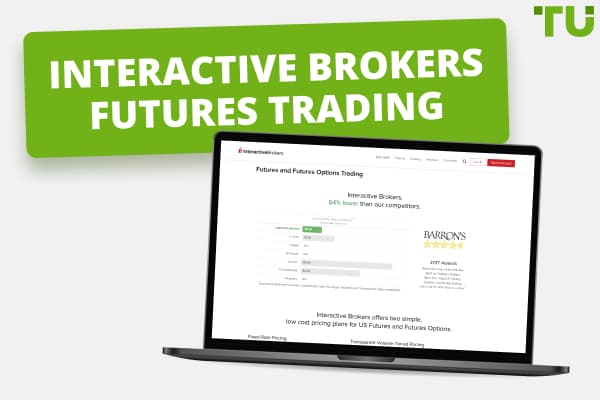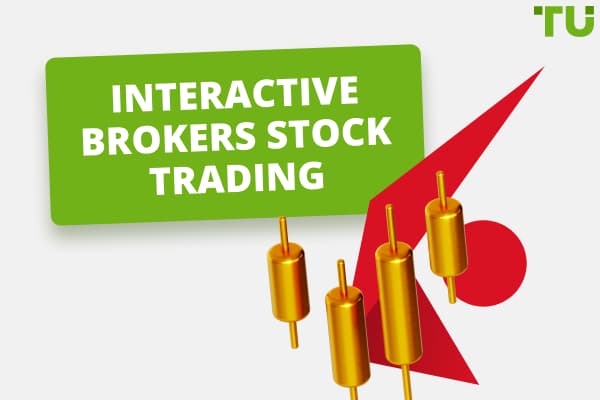
Interactive Brokers Margin Rates: All You Need To Know
Interactive Brokers has the lowest margin rates in the financial trading industry. The rates of USD margin loans are different from non-USD margin loans, for instance. The rates range for USD margin loans on the broker is 5.830% to 6.830%, while a non-USD margin loan differs based on the individual currency. Also, Interactive Brokers (IBKR) offer traders different margin sizes based on their residence and exchange location.
Interactive Brokers is a leading online trading platform that offers one of the lowest margin rates in the financial trading sector. Typically, margin trading involves borrowing funds to amplify trading positions for bigger potential profits. So, in this article, we provide you with essential information on how margin trading works, how Interactive Brokers calculate margin rates, the benefits of margin trading, and the risks involved.
-
How much margin can I get on Interactive Brokers?
Interactive Brokers (IBKR) offer traders different margin sizes based on their residence and exchange location. For instance, U.S. residents will get an initial margin of 25% x Stock value, a maintenance margin of 25% x Stock Value, Reg T End of Day Initial Margin of 50% x stock value, cash IRA cash of 100% x stock value, and Individual Retirement Account (IRA) margin would be same as cash for long positions.
-
Why is Interactive Brokers margin rate so low?
Why is Interactive Brokers margin rate so low? Interactive Brokers margin rate is so low because the platform earns from other aspects of their services.
-
Which brokerage has the lowest margin rates?
Interactive Brokers has one of the lowest margin rates in the financial trading industry.
-
Is IBKR good for day trading?
Yes. Interactive Brokers is an ideal platform for day trading because of its low margin rates and low commissions, which mitigate high trading costs.
Interactive Brokers Margin Rates For Different Products
Margin Rates For Stocks
Interactive Brokers margin rates for stocks can vary by tiers, which depend on factors such as the size of the loan, market condition, and the account base currency. So, the rates of USD margin loans are different from non-USD margin loans, for instance. The rates range for USD margin loans on the broker is 5.830% to 6.830%, while a non-USD margin loan differs based on the individual currency. For instance, the British pound sterling (GBP) has a margin rate of 5.637% to 6.637%.
Furthermore, the minimum margin requirement for stock on Interactive Brokers is determined based on the position. Therefore, the minimum margin required for a long position is 25% multiplied by the stock value (25% x stock value). Conversely, the minimum margin required for a short position is 30% multiplied by the stock's market value (30% x the stock's market value).
Margin Rates for Options
Interactive Brokers offer margin interest rates for options trading, which depend on factors such as the amount borrowed and the underlying asset. The rates range for USD margin loans on the broker is 5.830% to 6.830%, while a non-USD margin loan differs based on the individual currency. For instance, the euro (EUR) has a margin rate of 4.377% to 5.377%.
Besides, the minimum margin requirement for stock on Interactive Brokers varies based on option spread, option strategy, and position. For instance, the initial margin requirement for stock options in a Short Naked Call is 10% multiplied by the underlying price (10% x underlying price). On the other hand, the initial minimum margin requirement for a Short Naked Put is 10% multiplied by the strike price.
Margin Rates For Futures
Interactive Brokers USD margin rates for futures are calculated based on a tiered structure and the amount of margin borrowed. The rates range for USD margin loans on the broker is 5.830% to 6.830%, while a non-USD margin loan differs based on the individual currency. For example, the Japanese Yen (JPY) has a margin rate of 0.75% to 1.500%.
In addition, Interactive Brokers sets the minimum margin requirement for Futures based on risk-based algorithms, expressed in the currency of the traded product. Besides, the Minimum margin requirement for Futures can vary based on each exchange.
Margin Rates For Forex
Interactive Brokers also offers tiered margin rates based on the amount of margin borrowed. For instance, higher loan amounts typically attract lower interest rates and vice-versa. The rates range for USD margin loans on the broker is 5.830% to 6.830%, while a non-USD margin loan differs based on the individual currency. For example, the Swiss franc (CHF) has a margin rate of 2.000% to 3.000%.
The minimum margin requirement for Forex trading is determined by the traded currency pair and the size of the positions. So, Forex margin requirements are subject to adjustment by Interactive Brokers.
How To Calculate Interactive Brokers Margin Rates
Here is the formula for calculating margin rates on Interactive Brokers:
Margin Rate = BM + Spread + Surcharge.
Where MB: Benchmark Rate
-
Benchmark Rate: This is the referenced interest rate that determines the level of other interest rates.
-
Spread: This is the difference between the bench rate and the interest rate offered by Interactive Brokers.
-
Surcharge: This refers to charges added to the margin rate if financing is not pre-arranged. The surcharge on Interactive Brokers is typically 1% applied to the spread.
Example of Calculation
Let’s calculate the margin rate to borrow $20,000 on margin using the following values:
-
BM: 3.8%
-
Spread: 1.2%
-
Surcharge: 1%
Therefore, the margin rate will be 3.8% + 1.2% + 0.8% =5.8%.
Features of Margin Trading on Interactive Brokers
Margin trading in the financial markets involves borrowing funds to trade larger positions than the traders’ capital can allow. Margin trading can be grouped into securities margin and commodities margin.
Securities margin refers to borrowing money from the broker to buy financial instruments. On the other hand, commodities margin refers to the practice where traders use their capital as collateral to facilitate investing in stocks.
Benefits of a Margin Trading Account
-
Leverage: One of the major benefits of margin trading is that it increases traders' buying power in the market for bigger profit potential. With margin trading, traders can control a larger position size than their account could allow, assisting traders in maximizing bigger profits from winning trades.
-
Trading Strategy Diversification: Margin trading expands trading opportunities and strategies; it allows traders to short-sell currency, futures, options, or contract trading.
Risks of Margin Trading
Margin trading is a double-edged sword that has both potential benefits and risks. Therefore, let’s look into the key risks associated with margin trading:
-
Potential Margin Call: Margin trading increases the chances of a margin call if your positions fall below a certain threshold. In the face of a margin call, you might be required to deposit additional funds into your account or be liquidated, eventually.
-
Magnify losses: While margin trading can significantly magnify profits, it also magnifies losses if the trade does not go in the anticipated direction.
-
Interest Costs: Margin trading comes with additional interest costs to compensate Interactive Brokers on the borrowed funds.
How Trading Securities on Margin Works
Trading financial securities on margin involves two systems known as rules-based margin and risk-based margin.
-
Rules-based Margin: In this system, Interactive Brokers sets a fixed margin requirement of the total trade value that traders must maintain. The margin requirement differs for different securities, usually calculated with a defined formula.
-
Risk-based Margin: In this system, Interactive Brokers calculate the margin rates based on the risk associated with specific securities. Essentially, it assesses the potential volatility and market risk of each position to create margin requirements.
Factors that affect Interactive Brokers margin rates
Interactive Brokers (IBKR) determines its margin rates based on various factors to provide margin financing to traders. Here are the key factors that affect market rates on Interactive Brokers:
-
Account Balance: The account balance of traders can influence the margin rate provided by Interactive Brokers. In general, higher account balances tend to have lower margin rates because of the capacity of such accounts to cover potential losses. Conversely, lower account balances often attract higher margin rates to protect the broker’s money from a possible margin call due to the small account size.
-
Trading Volume: The frequency and volume of traders’ transactions can also affect the margin rates provided. For instance, traders with higher trading volume may get lower margin rates, while traders with smaller trading volume get higher margin rates.
-
Market Volatility: The prevailing volatility in the financial market is also another factor that can affect the margin rates provided by Interactive Brokers. The broker may increase or reduce margin rates in periods of high and low market volatility. For example, periods of high market volatility tend to experience higher margin rates to accommodate the heightened price fluctuations.
-
Instrument Volatility: Different instruments carry varying levels of risk. Some financial trading instruments are more volatile than others, which can influence the margin rates provided by Interactive Brokers. Typically, less liquid instruments tend to have lower margin requirements than instruments with higher liquidity.
-
Type of Asset: Interactive Brokers margin rates can be influenced by the type of asset being traded due to volatility and market capitalization. For instance, the margin rates for stocks differ significantly from options, etc.
Team that worked on the article
Joshua Francis is a professional Forex trader with 4+ years of experience in the financial industry. He trades the XAU/USD and GBP/JPY pairs. He is also a ghostwriter and author for Indicatorspot and Traders Union, where he puts his intensive research skills and deep knowledge of the financial markets into freelance writing.
Dr. BJ Johnson is a PhD in English Language and an editor with over 15 years of experience. He earned his degree in English Language in the U.S and the UK. In 2020, Dr. Johnson joined the Traders Union team. Since then, he has created over 100 exclusive articles and edited over 300 articles of other authors.
Mirjan Hipolito is a journalist and news editor at Traders Union. She is an expert crypto writer with five years of experience in the financial markets. Her specialties are daily market news, price predictions, and Initial Coin Offerings (ICO).










